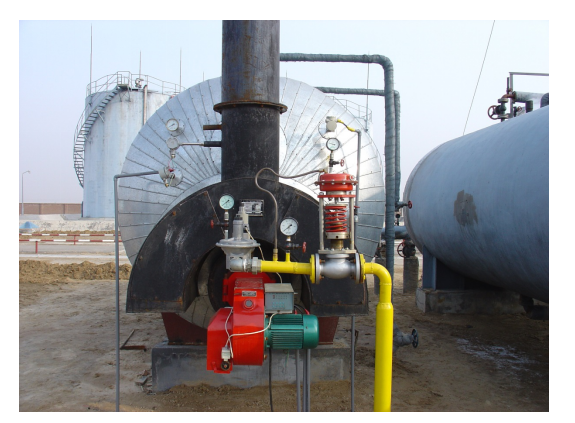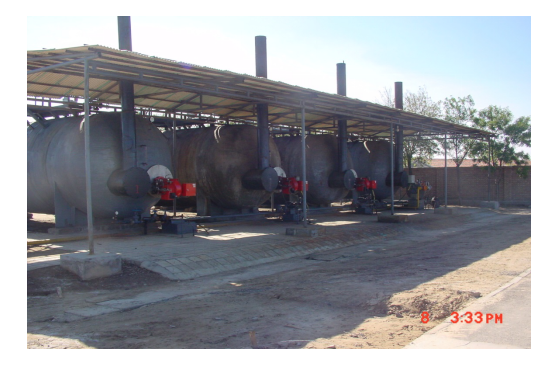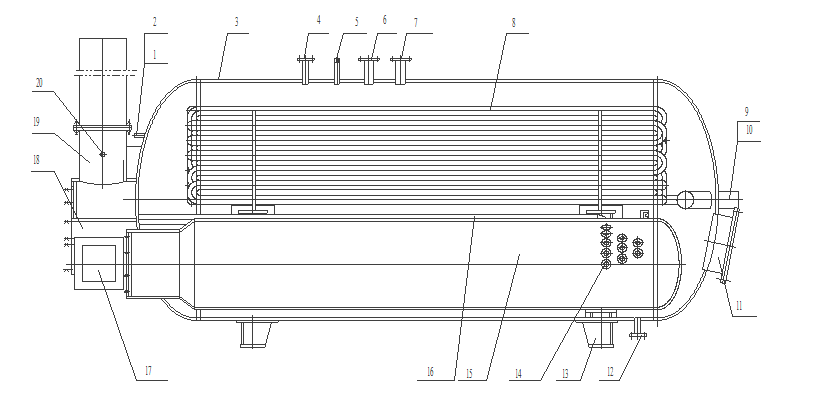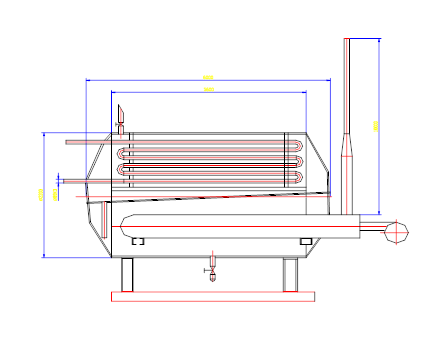

Oil Heater, an essential equipment in the production process, break up well stream emulsions, separating the crude oil from water and other foreign materials. Gas is liberated prior to the filtering and settling sections, allowing liquid and sediment separation without the agitation of gas breaking out of the liquid.
Horizontal Oil Heater
A horizontal treater can handle large amounts of emulsion by utilizing a long “U” shaped firetube. This firetube has greater heating capacity, thereby allowing a higher treating rate. The large horizontal interface area in the settling section allows for more efficient separation of emulsion and gas release. Horizontal crude oil heating units must operate under pressure to boost oil to storage tanks.
![1536656696950367.png _Q]Z2]G4V6N}YC1H7~C@3H3.png](/ueditor/php/upload/image/20180911/1536656696950367.png)
Reference drawings:

1. Temperature transmitter seat 2. Level switch seat 3. Shell 4. Crude inlet 5. Pressure gauge seat 6. Vent 7. Safety valve seat 8. Heating coils
9. Heat medium inlet 10. Heat medium outlet 11. Manhole 12. Drain outlet 13. Saddle 14. Inner ribbed smoke tube welding hole
15. Fire barrel 16. Inner ribbed smoke tube 17. Burner 18. Smoke box 19. Stack 20. Temperature gauge seat
1. Basic Description
Structure and performance design of water jacket furnace
1. The main structure of the water jacket furnace includes three parts: shell, heating coils and a heating system. The heating system is mainly composed of a fire barrel mainly radiating heat exchange, a smoke tube mainly convecting heat transfer and a stack. The affecting factors of thermal efficiency and structure size for water jacket furnace include the structure and performance of the heating system and the heating coil, as well as the properties of the heat medium and the heated medium, and the internal structure of the heating furnace.
2. The purpose of the furnace structure optimization is to strengthen the radiation heat transfer of the fire barrel and convection heat transfer of the smoke tube, reduce the smoke temperature and improve the thermal efficiency of the heating furnace. The second is to improve the furnace structure and overall configuration, reduce the furnace design pressure and metal consumption Quantity; third is to simplify the manufacturing process.
3. The optimization of the performance structure of the oilfield high efficiency water jacket furnace is mainly considered from the development of new fire barrel and smoke tube structure, improve the structure and arrangement of heating coils, optimize heat medium additives and optimize the overall structure, etc., to improve the technical performance indicators of the water jacket furnace.
Integral high efficiency water jacket furnace
1. The fire barrel and the heating coils of the integral high efficiency water jacket furnace are in the same shell and separated into two heat transfer units by a partition; The high temperature flue gas formed by the combustion of the fuel transfers heat to the fire barrel through radiation and convection. The barrel transfers the heat to the water. The water is heated to form steam. The steam rises through the opening at one end of the partition and enters the second heat transfer unit to exchange heat with the heated medium. After condensing into water, it returns to the first heat transfer unit by gravity. It is heated to form steam. The circulation is performed in sequence to transfer heat, and the heated medium is heated to a predetermined temperature.
Figure-1 Schematic diagram of Integral high efficiency water jacket furnace

The new type of high efficiency water jacket furnace uses phase change heat transfer technology to change the heat transfer method of the traditional water jacket furnace; and it adopts new technologies such as small inner ribbed smoke tube and micro-positive pressure combustion technology, compared with the traditional water jacket furnace , which has the advantages of low power consumption per unit of power steel, high thermal efficiency.
2. Due to the structure problems of the fire barrel and smoke tube, the three-dimensional inner ribbed tube enhanced heat transfer technology was adopted to increase the radiant heat transfer intensity of the fire tube and the convection heat transfer intensity of the smoke tube to redistribute the heat load of the radiant section of the heating furnace and the convection heat exchange section. In proportion, a new type structure of fire barrel and smoke tube (as shown in Fig. 2) has been optimized and designed. The three-dimensional inner ribbed tube is arranged on the side of the fire tube. One end is connected to the smoke box located at the bottom of the stack, and the other end is connected to fire barrel. Through welding, the three-dimensional inner rib smoke tube and fire barrel are arranged in the inner lower part of the water jacket furnace shell.

Figure-2 Schematic diagram of inner ribbed smoke tube and fire barrel
Fig. 3 A-A sectional view of the structure of inner ribbed smoke tube and fire barrel
The three-dimensional inner ribbed smoke tube and fire barrel structure has the following advantages over the conventional water jacket type furnace:
(1) By increasing the temperature of the furnace flue gas and enhancing the radiation heat transfer, the heat transfer intensity in the radiant section of the fire barrel is greatly increased, and the length of the fire barrel is reduced by about 50%;
(2) By adopting the three-dimensional inner ribbed tube enhanced heat transfer technology, the convective heat transfer coefficient of the smoke tube is increased by more than three times, and the temperature drop of the smoke tube is also increased, and the length of the smoke tube is reduced by about 50%.
(3) The structure of three-dimensional inner ribbed smoke tube and fire barrel can be arranged at the inner and lower parts of the shell, greatly reducing the amount of intermediate heat transfer medium, greatly reducing the heating capacity of the heating furnace, shortening the time for starting the furnace, and high-efficiency and energy-saving.
3. Structure improvement of heating coils
Since the heated medium of the oil field water jacket furnace is crude oil extracted from the oil well, it usually carries sand with a sediment content of 2‰ to 5‰. The small diameter steel tube is not suitable as heating coils. Early heating coils is made of a single tube, combined with more elbows, so the flow resistance is large. The new structure is to change the tubes of a single group of ф114 to two groups of ф89 tubes in parallel, which shortens the pipeline flow. The improved coil resistance is reduced from 0.2 MPa to 0.09 MPa.
In terms of enhanced heat transfer, taking into account the physical properties of the heated medium, spiral grooved tubes are mainly used, and the heat transfer efficient can generally be increased by about 50%, but the coil resistance is approximately doubled. Due to high cost of the spiral grooved tube, it is generally determined according to the nature of the medium to be heated or not after comprehensive evaluation.
4. Heat Medium Optimization
The increase of the temperature of the heated crude oil is mainly limited by the temperature of the intermediate heat medium. When water is used as the heat medium, the design temperature of the heat medium is 120 ° C to 150 ° C, the corresponding saturated vapor pressure is 0.2 MPa to 0.5 MPa, and the temperature of the heated crude oil is 70 ° C ~ 90 ° C, this temperature meets the needs of light crude oil and medium crude oil processing, but cannot meet the needs of heavy oil and ultra heavy oil processing (heavy oil dehydration temperature is generally around 110 ° C). Water jacket furnaces are generally operated under positive pressure. Due to the high temperature of the intermediate heat medium, there is a certain risk.
The design wall thickness of the furnace shell is mainly determined by the operating pressure. From the calculation formula of the furnace strength, the calculated wall thickness of the shell is proportional to the design pressure of the furnace, regardless of the corrosion allowance. Increasing the temperature of the heat medium, increasing the heat transfer temperature difference, and reducing the saturated vapor pressure of the heat medium are effective means for reducing the cost of the heating furnace.
The use of heat medium additives can reduce the saturated vapor pressure of water. In order to select suitable additive materials, various additives have been screened, and the addition of a mixture of potassium dichromate, potassium sulfate and alcohol has a significant effect on reducing the saturated vapor pressure of water. The additive is cheap, has no corrosive effect on the metal, does not harm the human body, and does not pollute the environment.
5. Application Development of Special Burners
Considering the fuel source, process requirements of the oil field high-efficiency water jacket furnace, the characteristics of the water jacket fire barrel structure, and the requirements for energy conservation and environmental protection, the followings must be taken into consideration when designing or selecting the burner:
5.1. The burner is adapted to the fuel characteristics. First of all, the fuel used in oilfield high-efficiency water jacket furnaces is natural gas or crude oil, forced ventilation, and micro-positive pressure combustion. Because the flame propagation speed of natural gas is quick and tempering is easy, an external mixing system should be adopted to avoid tempering which can cause mishaps; second, the burner should have a complete control system in order to effectively control the temperature of the heated medium to be released according to the process requirements.
5.2 The combustion should meet the technical requirements of the oil field high-efficiency furnace. First of all, the heat release of the burner should meet the requirements of the thermal load of the water jacket furnace. The pressure fluctuation of the oil and gas source in the oil field is relatively large, and the lower operating parameters should be used as the basis for design, ensure that the burner can achieve rated thermal load when operating under the lower parameters. In addition, in order to ensure the stable operation, the burner should have the gas regulator function; Second, the air blower for burner should have sufficient pressure head and good performance parameters, can overcome the oil field water jacket furnace smoke Resistance, and can ensure the stable combustion of fuel.
5.3. The burner should be compatible with the structural characteristics of the oil field high-efficiency water jacket fire barrel. The oil field high-efficiency water jacket furnace has a short fire barrel and a limited furnace depth, so the flame length of the burner should not be too long.
5.4. The burner should meet the requirements of energy conservation and environmental protection. The burner is an energy supply device for a high-efficiency water jacket furnace and must meet the requirements of environmental protection. This requires the burner to reduce its own losses as much as possible, and achieve a reasonable combustion with low oxygen with as little excess air ratio as possible.
In order to effectively control the excess air coefficient of the heating furnace and ensure the efficient operation of the oil field high-efficiency heating furnace, a high-efficiency, low-pollution special burner is developed and applied to the structure characteristics and resistance characteristics of the high-efficiency water jacket furnace. The special burner forced air supply with micro-positive pressure combustion not only improves combustion efficiency, but also reduces environmental pollution.
6. Drawings of burner control principle
![1536657181677526.png AO4YP`ARPLNV]@LI~E}M`~K.png](/ueditor/php/upload/image/20180911/1536657181677526.png)
The burner can automatically determine and control the operating state of the burner according to the process requirements, according to the crude oil inlet temperature, the outlet temperature, and the steam temperature of the heating furnace.
7. Water jacket furnace control system
The automatic control system of the new high-efficiency water-jacket furnace is based on the control parameter of the outlet temperature of the heated medium and the steam temperature as the secondary control parameter, and the single-path automatic regulation is implemented; the single-channel automatic protection is implemented in the pressure inside the shell, and the temperature at the outlet of the heated medium is not When the pressure in the housing exceeds the set value under the conditions of the specified value of the production process, it automatically switches to the low-fire operation state or flameout alarm; the burner is equipped with flame detection and electronic auto-ignition, and the electronic automatic ignition and flameout protection is implemented; Heat medium inlet and outlet temperature, pressure and fuel consumption are displayed online and automatically recorded.
Complete self-control system provides guarantee for the long-term safe operation of oilfield high-efficiency water jacket furnace, and basically meets the requirements of unmanned duty.
Water jacket furnace control system is mainly based on the outlet temperature of the heated medium and the temperature of the heating medium (water), through the analysis and judgment of the control system to determine a reasonable combination of large and small fire burner operation and switching to achieve fuzzy control. The control schematic is as follows
![1536657212136734.png I0]1K@%0RH`}WA$BU27J}Z9.png](/ueditor/php/upload/image/20180911/1536657212136734.png)